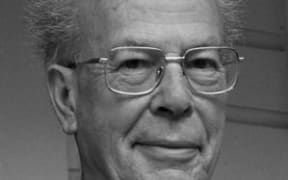David Farquhar
David Farquhar (1928-2007)
Equali - eight duos for two violins (1991)
Performers: Douglas Beilman & Dean Major (violins)
Recorded by Radio New Zealand in Studio One, Broadcasting House, Wellington
8 July 1991
On 8 May 2007, New Zealand lost one of its most accomplished and influential musical figures with the passing of David Farquhar at the age of 79. His significance is not simply a result of his outstanding output, but also because he founded the Composers Association of New Zealand; and was a long serving member of the New Zealand Composers Foundation. He was made a Companion of the New Zealand Order of Merit in 2004 for his services to New Zealand music.
David had the good fortune to be born in the Waikato town of Cambridge and to attend St Peter's School. There, he came under the tutelage of the school's founding headmaster, Arthur F. B. Broadhurst, who was able to give the young David an extraordinary musical education for the time. He studied singing, piano, organ and the cello, and at the age of eleven was writing songs and piano pieces.
He studied in Christchurch, Wellington, the English university town of Cambridge and at the Guildhall School of Music in London. He returned to New Zealand at the age of 25 for a teaching job at Victoria University of Wellington, alongside Douglas Lilburn and Frederick Page.
I became aware of David as an 18-year-old percussionist with the Christchurch Symphony Orchestra in the first (and to my knowledge only) performance of a specially commissioned oratorio called Bells In Their Seasons. I was the one playing the bell part which, as you can imagine with a title like that, was reasonably extensive. David, as the composer, was very kind and helpful to me. Thirty years later I was given the opportunity to record his three symphonies with the NZSO, and that is a source of great pride and enjoyment for me.
Tonight we're going to hear a 1991 recording of David Farquhar's Eight Equali for two violins. These are excellent studies in contrapuntal writing with oodles of imitation, canon and rhythmic interplay.
Farquhar himself said: "I was particularly interested in exploring the interweaving and crossing of the two violin lines and the idea of dividing lines between them. I have always been drawn to the idea of duos […] but the warmth and expressiveness of stringed instruments has a special appeal which I hope comes across in this set."
Galling as it can be to have someone prattle on about the technical detail of a piece of music, I feel compelled to do so on this occasion, since I feel these 8 short pieces vividly demonstrate the delight David took in setting himself and solving specific compositional puzzles, just for the hell of it.
The first movement is characterised by the two violins imitating each other in their entries. The main theme is 4 whole tone steps plus a fourth, both ascending and descending.
The second is based around an overtly typical, jaunty, syncopated semitone rhythmic motive which ends with a raised or lowered fifth – listen for the one prominent note at the end of phrases. This is freely bandied around between the two instruments.
The third piece opens with a one-note rhythmic motive in 6/8 which expands out to the sixth. However, the ending is quiet and ambiguous.
Next we have a lyrical Larghetto very much in E minor which emphasises, appropriately, the interval of a minor third.
The fifth piece is a gentle 9/8 with the first voice weaving lines based around major, minor and diminished arpeggios above the counterpoint of the second voice concerned with bare fifths and a major seventh. You can hear the second violin jumping around with those large intervals at the top of the piece here.
If it is possible to have a miniature sonata form for 2 violins over only 45 bars and lasting 1¾ minutes then the sixth piece demonstrates it perfectly. There are two melodic motives, shared between the violins, which are consequently developed with expert use of back-and-forth imitation. As sonata form dictates, there’s a recapitulation which inverts the two themes before the piece ends with a quiet coda. Clever chap Farquhar?
The seventh movement is marked Grazioso. It begins with a four note motive, which is played inverted straight afterwards. Both instruments go on to toy with it in various permutations.
The final Vivace is a vaguely hesitant example of a waltz; a dance that David was particularly fond of and which frequently resulted in some of his loveliest music.
